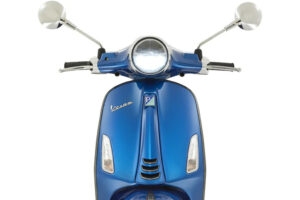Distinctive style and timeless design: 50 years after its introduction, the Vespa Primavera 125 is still a timeless classic.
The Vespa Primavera
Loved, hated, “re-read” and re-interpreted – 1968 remains a turning point and a year of great change. A real cultural turning point that profoundly shaped the development of society in the Western world. And it was also a fundamental year in the field of engines, especially two-wheelers: while Honda presented the Four 750 at the Tokyo Motor Show, which was to become the legendary progenitor of all Japanese four-cylinder racing bikes, Piaggio launched the first edition of the Vespa Primavera. A young and zippy version of the legendary scooter from Italy that would soon become one of the icons of a rebellious and high-spirited generation.
The year 1968
In 2018, 50 years after the revolutionary year of 1968, the Italian brand presents a new version of this great classic: Together with the Sprint and GTS versions, the Vespa Primavera takes up the legacy of its famous ancestors without distorting their DNA, but manoeuvres itself into the future. We tested the most aggressive and sporty version of the Primavera with an eight-litre, the Vespa Primavera 125 S: a particularly sharp and fashionable version, available from €4,940.

The 125 S PRIMAVERA – WHAT DOES IT LOOK LIKE?
One look is enough to understand that even after half a century, it is still the Primavera. The Vespa is in itself a timeless legend, and the 125 S in particular is certainly no exception. On the contrary, the styling is strongly influenced by the 70-year history of the world’s most famous scooter. The allusions to earlier models are obvious, and the citations of tradition are as numerous as the chrome plating. In this new edition, the classic design of the Primavera, characterised by soft lines with a touch of tradition, has been enriched by a new “tie” at the front and a chromed emblem on the front mudguard, details common to all versions, as well as by the new LED lighting front and rear.
Innovations
The most important innovation from a technical point of view are certainly the rims and their size. For the first time in Vespa history, there are two 12-inch alloy wheels with five spokes front and rear, the largest diameter ever seen on a Piaggio commuter. The braking system consists of a 200 mm disc at the front combined with a single-channel ABS system, while a less refined drum is used at the rear, which apparently does not have an anti-lock braking system.
Mobility
The watchwords of this Primavera are the same as those of its ancestors. Mobility and practicality in unique Vespa style, with that vintage touch that makes the Pontedera scooter a true classic. The compact dimensions of the 125 S make it the ideal vehicle for gliding through city traffic. The short wheelbase and tight turning radius give it surprising agility in the urban jungle, and combined with a seat height of just 790 mm and limited weight, even those with little or no experience on two wheels feel at home. These excellent dynamic characteristics are certainly also due to the suspension department and the increased diameter of the wheels, which translates into increased stability and safety even on a less than perfect road surface.
Comfort of the Primavera
Comfort is perfectly satisfactory in city traffic, but for those travelling with two people – perhaps on an out-of-town excursion – space is not at a premium. In a sense, this is the price you pay for the impressive speed the Primavera guarantees in the midst of rush-hour traffic. The compactness and lighter weight add even more oomph to an engine that has proven to be exceptionally brilliant and lively. It is capable of acceleration and extension that does not make you regret engines with larger displacement. A really nice little city cruiser, considering how small the Vespa’s displacement is!




Comments (1)